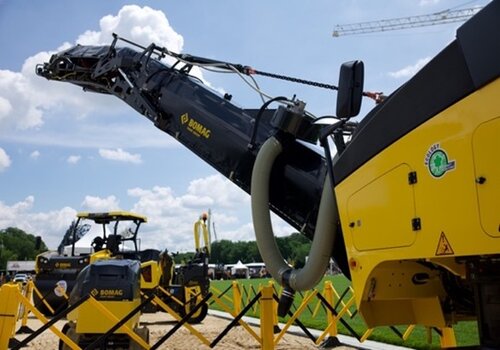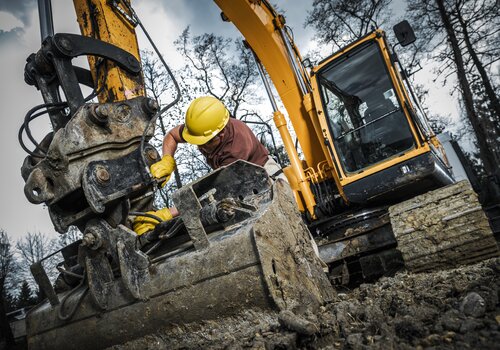Electric trucks and construction equipment come with a premium price tag. For example, in the pickup category, the 2023 F-150 Lightning with pro trim starts at $46,974 plus destination fees, via Kelley Blue Book. The International Council on Clean Transportation estimates that a 2022 Class 8 electric truck costs two to three times its diesel counterpart before incentives. For construction equipment, the initial purchase price can be nearly twice as much as comparable diesel versions. Incentives from federal, state, and local government agencies and utilities make electric vehicles more feasible. Here’s a roundup of available incentives and where to look for them.
Inflation Reduction Act Tax Credit for Vehicles & Mobile Machinery
Since the Inflation Reduction Act (IRA) became law in August 2022, media attention has been focused on Section 30D and incentives for consumer electric vehicles, including numerous new requirements such as final assembly in North America and the sourcing of critical minerals used in EV batteries. There has been little mention that the IRA created IRC Section 45W to provide a new credit for qualified commercial clean vehicles and mobile machinery acquired before Jan. 1, 2033.
“If you use the vehicles in a trade or business and meet the standards, a lot of the limitations introduced in 30D, are not there,” says Daniel Kiely, partner and member of Mayer Brown’s Global Tax Practice.
Beginning Jan. 1, 2023, a tax credit will be available to businesses for the purchase of new EVs (electric vehicles) and FCEVs (fuel cell electric vehicles). Vehicles with a gross vehicle weight rating (GVWR) below 14,000 pounds must have a battery capacity of at least seven kilowatt-hours (kWh) and vehicles with a GVWR above 14,000 lbs. must have a battery capacity of at least 15 kWh.
What is the tax credit worth?
The tax credit amount is equal to the lesser of the following amounts:
- 15% of the vehicle purchase price for plug-in hybrid electric vehicles
- 30% of the vehicle purchase price for EVs and FCEVs
- The incremental cost of the vehicle compared to an equivalent internal combustion engine vehicle
Maximum tax credits may not exceed $7,500 for vehicles under 14,000 pounds. and $40,000 for vehicles above 14,000 pounds.
According to Kiely, who co-authored an article on the topic for Mayer Brown, the tax credit under Section 45 includes some very significant differences that may make it easier to qualify for than the credits for individual taxpayers (Section 30D).
First, the credit amounts under Section 45W are not subject to satisfying critical minerals or battery component requirements and are not subject to income limits or MSRP caps. There is no requirement for assembly in North America, nor does original use need to commence with the taxpayer.
Construction firms should also note that the credits extend to “mobile machinery,” as well as certain fuel cell vehicles.
“Mobile machinery is generally understood to include many more types of vehicles than motor vehicles that are used for over-the-road transportation, including forklifts and commercial lawnmowers,” says Kiely. “This suggests that the tax credit under Section 45W may be available for taxpayers that acquire such vehicles even though these vehicles would not be eligible for a tax credit under Section 30D, which is limited to vehicles manufactured primarily for use on public streets, roads, and highways.”
Kiely says it would be helpful if the Internal Revenue Service (IRS) and Treasury provided more clarity on precisely what machinery would qualify. But while the law directs the IRS and Treasury to provide further guidance, there is no specific deadline.
Another issue is a requirement that the taxpayer includes the VIN number of the vehicle on their tax return since mobile machinery typically has a serial number, not a VIN number. “This inconsistency should also be addressed in subsequent guidance,” says Kiely.
Qualified vehicles Section 45W
To qualify for the tax credit under Section 45W, a vehicle must meet the following requirements:
- It must be made by a qualified manufacturer;
- It must be acquired for use or lease by a taxpayer and not for resale;
- It must be treated as either (i) a motor vehicle for purposes of title II of the Clean Air Act and manufactured primarily for use on public streets, roads, and highways (not including a vehicle operated exclusively on a rail or rails) or (ii) “mobile machinery” for purposes of the federal excise tax on heavy trucks;
- It either (i) is propelled to a significant extent by an electric motor that draws electricity from a battery that has a capacity of not less than 15-kilowatt hours (or, in the case of a vehicle that has a gross vehicle weight rating of fewer than 14,000 pounds, 7-kilowatt hours) and is capable of being recharged from an external source of electricity or (ii) is propelled by power derived from certain fuel cells (or meets certain emission standards established by the Environmental Protection Agency); and
- It must be subject to the allowance for depreciation. There is an exception to this requirement for any vehicle that is not subject to a lease and that is placed in service by a tax-exempt entity other than a foreign person or entity.
State and Local Incentives
In addition to federal incentives, state and local utility incentives are available for electric vehicles in all 50 states and the District of Columbia. Incentives include rebates, as well as discounted utility rates, and other credits. Most rebates can either be claimed after purchase or reflected as a reduction in the price of your purchase.
Pacific Gas & Electric (PG&E) serves a 70,000-square-mile service area in northern and central California. offers rebates for the purchase of electric fleet vehicles that can be used to offset the cost of infrastructure upgrades. Construction is included on the list of industries covered.
California is one of the few states with funds set aside specifically to encourage the purchase or lease of zero-emission off-road equipment through its Clean Off-Road Equipment Voucher Incentive Project (CORE). Qualified participants will receive vouchers for point-of-sale discounts on off-road zero-emission equipment, up to a maximum of $500,000 per voucher. In 2022, $125 million in funding is available. CORE-approved dealers are responsible for securing CORE voucher funding through the online Voucher Processing Center. Eligible construction equipment includes excavators, dozers, skid-steers, and backhoes.
The Department of Energy’s Alternative Fuels Data Center is a good place to start when searching for incentives. You can narrow your search by technology, type of incentive, and type of user.
Alternative Fuel Infrastructure Tax Credit
Charging equipment is a key expense when it comes to converting to electric vehicles. Fortunately, tax credits are available. Beginning Jan. 1, 2023, the Alternative Fuel Infrastructure tax credit provides a tax credit of 30% of the cost or 6% in the case of property subject to depreciation, not to exceed $100,000. The key stipulation is that the equipment must be installed in a population census tract where the poverty rate is at least 20% or a metropolitan and non-metropolitan area census tract where the median family income is less than 80% of the state medium family income level.
EV Connect, an open-charging platform, is guiding companies in building out charging infrastructure and managing networks of chargers. To help evaluate the incentives the EV Connect website includes a calculator to find savings based on the company’s zip code and industry. According to the company’s website, their products and services are currently approved for over $2.6 billion in active utility and local government incentive programs supporting EV charging for businesses that are looking to support transportation electrification for their own feet, their customers, or their communities.
According to Ram Ambatipudi, Senior Vice President of Energy and Utilities at EV Connect, the ability of a customer that is installing EV Charging at their business to keep their chargers private, public, or split between the two is largely dependent on the specific requirements of the incentive programs. “Many programs that are specifically targeted to expand public charging will require chargers to be made available to the general public,” says Ambatipudi. “Other programs that target workplace or fleet use cases allow the chargers to be made private or split (private and public).” For this reason, he cautions businesses to thoroughly understand the incentive program eligibility requirements as well as their desired use case to determine which programs will satisfy their needs.
EV charging is a way for businesses to offset environmental impacts and encourage clean energy use. “EV Connect’s Charging-as-a-Service (CaaS) can further reduce the upfront capital cost of deploying charging infrastructure,” says James Ellis, Director of Energy and Utilities at EV Connect “This product takes the initial purchase requirement of equipment out of the equation and turns a capital cost into an operating cost – simplifying charging station deployment for the business. They get their property ready – and we do the rest!”
There is a lot to consider when determining if electric equipment is right for your business. Read “What to consider when you’re on the fence about electric equipment.” But if you do make the investment, be sure to get the credit you deserve.
Read Next
5 Things to Consider If You're on the Fence About Electric Equipment Ownership
Get Smarter About Electric Construction Equipment
5 Ways Owning an Electric Vehicle is Different From Owning a Diesel Machine












